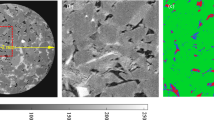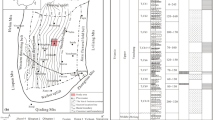Abstract
Overall pore-throat size distribution is a critical foundation for evaluating tight sandy conglomerate reservoirs. However, the pore-throat size cannot be easily obtained from a single technic due to the complex microstructure. In this paper, a new method was introduced to characterize the microstructure by combining thin sections, scanning electron microscopy (SEM), pressure-controlled injected mercury (PMI), rate-controlled injected mercury (RMI), and nuclear magnetic resonance (NMR). Twenty-four tight sandy conglomerate cores from the Baikouquan Formation of the Mabei oil field, northwest China, were selected to conduct the series of experiments. Overall pore-throat size distribution (TRD) was reconstructed by combining mercury injection porosimetry (MIP) with NMR with pores that were equivalent to triangular cross-section; the radii of the inscribed spheres were obtained to weaken the influence of irregular shapes by RMI. Irreducible water saturation of the cores was achieved by nitrogen displacement, which decreases with increasing of micropore proportion. An ideal relationship between permeability, movable water saturation, and micropore percentages was constructed which indicates the effect of microstructure on reservoir quality and fluid distribution in tight sandy conglomerate reservoirs.










Similar content being viewed by others
References
Chen M, Li M, Zhao JZ, Kuang Y (2018a) Irreducible water distribution from nuclear magnetic resonance and constant-rate mercury injection methods in tight oil reservoirs. Int J Oil, Gas Coal Technol 17(4):443–457
Chen M, Dai JC, Liu XJ, Qin MJ, Pei Y, Wang ZT (2018b) Differences in the Fluid Characteristics between Spontaneous Imbibition and Drainage in Tight Sandstone Cores from Nuclear Magnetic Resonance. Energy & Fuels 32 (10):10333–10343
Clarkson CR, Jensen JL, Blasingame TA (2011) Reservoir engineering for unconventional gas reservoirs: what do we have to consider? SPE 1–45
Clarkson CR, Solano N, Bustin RM, Bustin AMM, Chalmers GRL, He L, Melnichenko YB, Radliński AP, Blach TP (2013) Pore structure characterization of North American shale gas reservoirs using USANS/SANS, gas adsorption, and mercury intrusion. Fuel 103(1):606–616
Ghanizadeh A, Clarkson CR, Aquino S, Ardakani OH, Sanei H (2015) Petrophysical and geomechanical characteristics of Canadian tight oil and liquid-rich gas reservoirs: II. Geomechanical property estimation. Fuel 153(1):682–691
Jorand R, Fehr A, Koch A, Clauser C (2011) Study of the variation of thermal conductivity with water saturation using nuclear magnetic resonance. J Geophys Res Solid Earth 116(B8):4684–4698
Kampschulte M, Langheinirch AC, Sender J, Litzlbauer HD, Althöhn U, Schwab JD, Alejandre-Lafont E, Martels G, Krombach GA (2016) Nano-computed tomography: technique and applications, Fortschr. Rontgenstrasse 188(2):146–154
Klaver J, Desbois G, Urai JL, Littke R (2012) BIB-SEM study of the pore space morphology in early mature Posidonia Shale from the Hils area, Germany. Int J Coal Geol 103(23):12–25
Leng ZP, Lv WF, Ma DS, Liu QJ, Jia NH, Li T, Jin X, Li DY (2015) Characterization of pore structure in tight oil reservoir rock, SPE 1–8
Loucks RG, Reed RM, Ruppel SC, Hammes U (2012) Spectrum of pore types and networks in mudrocks and a descriptive classification for matrix-related mudrock pores. AAPG Bull 96(6):1071–1098
Mayo S, Josh M, Nesterets Y, Esteban L, Pervukhina M, Clennel MB, Maksimenko A, Hall C (2015) Quantitative micro-porosity characterization using synchrotron micro-CT and xenon K-edge subtraction in sandstones, carbonates, shales and coal. Fuel 154:167–173
Neasham JW (1986) Applications of scanning electron microscopy to characterization and evaluation of reservoir rocks. Am Assoc Pet Geol Bull 70(5):15–18
Qiao J, Zeng J, Yang Z, Feng X, Yao JL, Luo AX (2015) The Nano-macro pore network and the characteristics of petroleum migration and accumulation in Chang 8 tight sandstone reservoir in Heshui, Ordos Basin. Acta Geol Sin (Eng Ed) 89(S1):207–209
Rouquerol J, Avnir D, Fairbridge CD, Everett DH, Haynes JH, Pernicone N, Ramsay JDF, Sing KSW, Unger KK (1994) Guidelines for the characterization of porous solids. Pure Appl Chem 66(8):1739–1758
Schmitt M, Fernandes CP, Neto JABDC, Wolf FG, Dos Santos VSS (2013) Characterization of pore systems in seal rocks using nitrogen gas adsorption combined with mercury injection capillary pressure techniques. Mar Pet Geol 39(1):138–149
Tinni A, Odusina E, Sulucarnain I, Sondergeld C, Rai CS (2015) Nuclear-magnetic-resonance response of brine, oil, and methane in organic-rich shales. SPE Reserv Eval Eng 18(3):400–406
Volokitin Y, Looyestijn WJ, Slijkerman WFJ, Hofman JP (2001) A practical approach to obtain primary drainage capillary pressure curves from NMR core and log data. Petrophysics 42(4):334–343
Wang C, Li T, Gao H, Zhao JS, Li HA (2017) Effect of asphaltene precipitation on CO2-flooding performance in low-permeability sandstones: a nuclear magnetic resonance study. RSC Adv 7(61):38367–38376
Washburn EW (1921) The dynamics of capillary how. Phys Rev Lett 17(3):273–283
Xi K, Cao Y, Haile BG, Zhu RK, Jahren J, Bjørlykke K, Zhang XX, Hellevang H (2016) How does the pore-throat size control the reservoir quality and oiliness of tight sandstones? The case of the lower Cretaceous Quantou formation in the southern Songliao Basin, China. Mar Pet Geol 76:1–15
Xiao L, Mao ZQ, Wang ZN, Jin Y (2012) Application of NMR logs in tight gas reservoirs for formation evaluation: a case study of Sichuan basin in China. J Pet Sci Eng 81(2):182–195
Xiao DS, Lu SF, Lu ZY, Huang W, Gu MW (2016a) Combining nuclear magnetic resonance and rate-controlled porosimetry to probe the pore-throat structure of tight sandstones. Pet Exp Dev 43(6):1049–1059
Xiao L, Wang H, Zou CC, Mao ZQ, Guo HP (2016b) Improvements on "Application of NMR logs in tight gas reservoirs for formation evaluation: a case study of Sichuan basin in China". J Pet Sci Eng 138(2):11–17
Yao Y, Liu D (2012) Comparison of low-field NMR and mercury intrusion porosimetry in characterizing pore size distributions of coals. Fuel 95:152–158
Yao YB, Liu DM, Che Y, Tang DZ, Tang SH, Huang WH (2010) Petrophysical characterization of coals by low-field nuclear magnetic resonance (NMR). Fuel 89(7):1371–1380
Yuan HH (1991) Advances in apex technology: determination of cementation exponent and absolute permeability. Log Anal 32(5):557–570
Yuan HH, Swanson BF (1989) Resolving pore-space characteristics by rate-controlled porosimetry. SPE Form Eval 4(1):17–24
Zhao H, Ning Z, Wang Q, Zhang R, Zhao TY, Niu TF, Zeng Y (2015) Petrophysical characterization of tight oil reservoirs using pressure-controlled porosimetry combined with rate-controlled porosimetry. Fuel 154:233–242
Zou CN (2017) Unconventional petroleum geology. Part III: unconventional petroleum miscellany. Chapter 9-tight oil and gas, Petroleum Industry Press, pp 239–273
Acknowledgments
The authors would like to thank the help from the Xinjiang Oilfield Company, CNPC.
Funding
This project was supported by the National Natural Science Foundation of China (No. 41804141) and the Chinese Postdoctoral Science Foundation (NO.2018M643525). And this work was also supported by the Scientific Research and Technology Development Project of CNPC (No. 2016D-3802) and the National Key Basic Research Program of China (973 Program) (No. 2015CB250902).
Author information
Authors and Affiliations
Corresponding author
Rights and permissions
About this article
Cite this article
Chen, M., Dai, J., Liu, X. et al. Contributions of pore-throat size distribution to reservoir quality and fluid distribution from NMR and MIP in tight sandy conglomerate reservoirs. Arab J Geosci 12, 9 (2019). https://doi.org/10.1007/s12517-018-4153-7
Received:
Accepted:
Published:
DOI: https://doi.org/10.1007/s12517-018-4153-7




